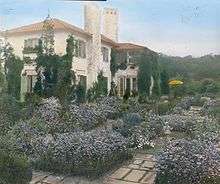Olmsted Brothers
The Olmsted Brothers company was an influential landscape architectural firm in the United States, established in 1898 by brothers John Charles Olmsted (1852–1920) and Frederick Law Olmsted Jr. (1870–1957), sons of the eminent landscape architect Frederick Law Olmsted.[1]

History
The Olmsted Brothers inherited the nation's first landscape architecture business from their father Frederick Law Olmsted.[2] This firm was a successor to the earlier firm of Olmsted, Olmsted and Eliot after the death of their partner Charles Eliot in 1897. The two brothers were among the founding members of the American Society of Landscape Architects (ASLA) and played an influential role in creating the National Park Service. Prior to their takeover of the firm, Frederick Law Olmsted Jr. had worked as an apprentice under his father, helping to design projects such as Biltmore Estate and the World's Columbian Exposition before graduating from Harvard University. The firm employed nearly 60 staff at its peak in the early 1930s. Notable landscape architects in the firm included James Frederick Dawson and Percival Gallagher.[3][4] The last Olmsted family member in the firm, Frederick Law Olmsted Jr., retired in 1949.[5] The firm itself remained in operation, moving from Brookline in 1980 and continuing in Fremont, New Hampshire until 2000. This created one continuous firm from 1858–2000.[6]
Office and archives
"Fairsted"—the firm's 100-year-old business headquarters and design office—has been carefully preserved as the Frederick Law Olmsted National Historic Site, located on 7 acres (2.833 ha) of landscaped grounds at 99 Warren St., Brookline, Massachusetts.[7] It offers excellent insights into the practice of large-scale landscape design and engineering. The site also houses an archive (access by appointment only) of the firm's designs, plant lists, and photos for hundreds of projects.
Design work
The Olmsted Brothers completed numerous high-profile projects, many of which remain popular to this day, including park systems, universities, exposition grounds, libraries, hospitals, residential neighborhoods and state capitols. Notable commissions include the roadways in the Great Smoky Mountains and Acadia National Parks; Yosemite Valley; Atlanta's Piedmont Park; Uplands; New York City's Central Park; university campuses like Washington University in St. Louis; residential neighborhoods in Oak Bay, British Columbia, Canada, and Oakland, California, including the street layout for what is now the Lakeshore Homes Association[8] (the oldest homeowners' association west of the Mississippi River and which includes parts of Oakland's historic Crocker Highlands and Trestle Glen neighborhoods);[9] entire park systems in cities such as Cleveland, Portland, Seattle;[10] and Washington state's Northern State Hospital. The Olmsted Brothers also co-authored, with Harland Bartholomew, a 1930 report for the Los Angeles Chamber of Commerce entitled "Parks, Playgrounds, and Beaches for the Los Angeles Region" encouraging the preservation of outdoor public space in southern California.[11] The report was largely ignored by the city, but became an important urban planning reference. In addition to these higher profile projects, the Olmsted Brothers took on projects beautifying residential areas.
See also
References
- Beveridge, Charles E. "The Olmsted Firm—An Introduction". Olmsted.org. Retrieved 22 August 2017.
- "1898-1980: Olmsted Brothers". The Cultural Landscape Foundation. Retrieved 22 August 2017.
- "Percival Gallagher". The Cultural Landscape Foundation. Archived from the original on 2012-02-22. Retrieved 2012-04-11.
- "Percival Gallagher". Smithsonian Institution Research Information System: Archives, Manuscripts and Photographs Catalog. Retrieved 2012-04-11.
- Valerie Easton (27 April 2003). "Masters Of Green". The Seattle Times. seattletimes.com. Retrieved 2012-04-11.
- Filler, Martin (November 5, 2015). "America's Green Giant". New York Review of Books. 62 (17): 16. Retrieved November 8, 2015.
- Zaitzevsky, Cynthia. Fairsted: A Cultural Landscape Report for the Frederick Law Olmsted National Historic Site. Internet Archive. Retrieved 22 August 2017.
- Lakeshore Homes Association
- "Our History". Lakeshore Homeowner's Association. Lakeshore Homeowner's Association. Retrieved March 14, 2020.
- David B. Williams (May 2, 1999). "The Olmsted Legacy -- The Fabled Massachusetts Landscape Firm Got To Seattle Early, And That Has Made All The Difference". The Seattle Times. seattletimes.com. Retrieved April 11, 2012.
- Hise, Greg; Deverell, William (June 7, 2000). Eden by Design: The 1930 Olmsted-Bartholomew Plan for the Los Angeles Region. University of California Press. ISBN 978-0-520-22415-5.
External links
| Wikisource has original works written by or about: Olmsted Brothers |
- Olmsted His Essential Theory
- Olmsted Parks in Seattle -- A Snapshot History at HistoryLink.org
- Olmsted Associates: A Register of Its Records in the Library of Congress, Manuscript Division
- Olmsted Research Guide Online a search tool for Olmsted projects and archival records
- Frederick Law Olmsted National Historic Site preserved home, office and archives of Olmsted firm, National Park Service
- National Association for Olmsted Parks
- Filson Historical Society|accessdate=15 April 2015 In the Filson Archives: Olmsted Brothers (landscape designers), 420, 580, 848.